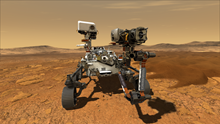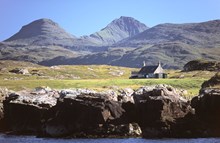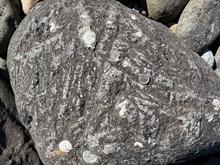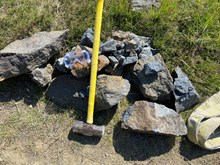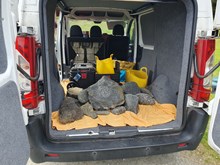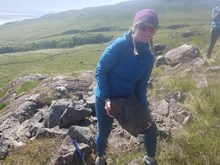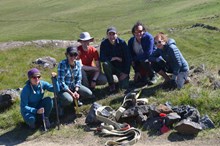28 July, 2023
Rum rocks to play a key role in Mars space mission
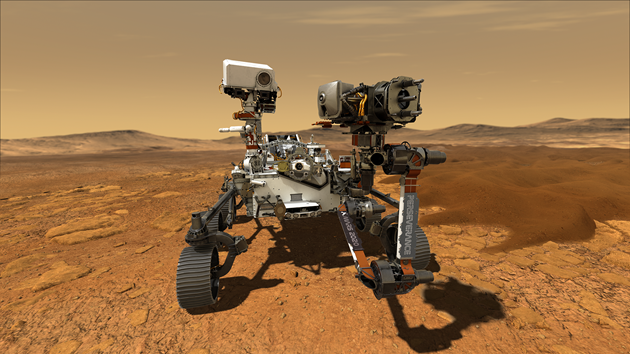
Ancient rocks from the Isle of Rum are playing an important role in an international space mission to discover more about Mars.
A group of scientists have this week been collecting samples of rock from the NatureScot National Nature Reserve (NNR) as part of the NASA and European Space Agency (ESA)’s Mars Sample Return Campaign.
The campaign is assembling a defined set of rock samples from around the world that are comparable to rock samples from the Red Planet that are scheduled to be brought to Earth in 2033.
Due to its unique geology, Rum off the west coast of Scotland has been selected as the only UK site for sampling, as some of its igneous rocks have a very similar mineral and chemical content to those that have been collected by NASA’s Perseverance Rover during its exploration of an ancient crater on Mars.
Intensive study of the rocks from Rum and other high-priority sample sites will crucially help scientists understand what methods of testing and analysis will work best in readiness for when the Martian rocks are brought to Earth.
As the first samples from another world, the Mars rocks are thought to present the best opportunity to reveal clues about the early evolution of the planet, including the potential for past life.
The Rum sampling is being led by Dr Lydia Hallis, a geologist and planetary scientist from the School of Geographical and Earth Sciences at the University of Glasgow, and member of the campaign’s Science Group. The field team also included Dr Luke Daly from the University of Glasgow, Professor Helen Williams and Dr Simon Matthews from the University of Cambridge, Professor John Bridges from the University of Leicester and Dr Mariek Schmidt from Brock University in Canada.
Dr Hallis said: “These Rum rocks are an excellent comparison to a specific geologic unit on Mars - the igneous Séítah Formation within the Jezero crater – which is characterized by the mineral olivine, and which the NASA Perseverance Rover explored and sampled. Not only is the mineralogy and chemistry similar, but the two rocks appear to have a similar amount of weathering.
“This seems strange when we think how wet and warm Rum is compared to present day Mars, but billions of years ago when the Séítah Formation crystallised on Mars the difference in environment would not have been so pronounced. At this time Mars was much wetter and warmer, with a thicker atmosphere that may even have produced rain (though not as much as we get in Scotland!). Over time the Martian atmosphere thinned leaving the surface much dryer and colder, essentially halting any further weathering within Séítah and preserving the rocks at Jezero Crater for us to investigate today.
“The rocks on Rum are younger geologically than those that have been collected on Mars by Perseverance, but their exposure to the Scottish elements has produced roughly the same amount of weathering as was produced in the Séítah Formation during Mars’ early wet and warm climate. Because of all these similarities, analysis of the Rum rocks should give us a good head start and help the samples from the Red Planet achieve their full potential when they are returned to Earth.”
Professor John Bridges, from Space Park Leicester, said: “The Rum rocks we collected will undergo the same types of analyses and in the same stringent conditions of laboratory cleanliness and protection as the Perseverance rover drill cores so that the science community is ready for the returned Jezero samples.”
Dr Mariek Schmidt, from Brock University in Canada, added: “It is very exciting to see rocks like those we encountered on Mars in the field on Earth. We were able to strike it with a hammer, feel its heft, and scan a broken surface with a hand lens.”
Lesley Watt, NatureScot’s Rum NNR reserve manager, said: “With its extinct volcanoes and dramatic mountains, Rum has always been one of the best places to discover Scotland's world-class geology, but we didn’t quite realise that the rocks here were of interplanetary significance as well.
“It has been fascinating to learn more about the NASA/ESA mission, and really exciting for the island to play a small part in this truly historic endeavour to find out more about Mars. We hope it will add yet another element of interest for visitors to this special place.”
Video footage available on request. Please contact University of Glasgow Communications Manager Ross Barker - 07816 984 686 / Ross.Barker@glasgow.ac.uk
For interview requests:
University of Glasgow - Communications Manager Ross Barker - 07816 984 686 / Ross.Barker@glasgow.ac.uk
NatureScot - Media Team - 0131 316 2655 / MEDIA@nature.scot
University of Cambridge - Press Office - Sarah.Collins@admin.cam.ac.uk
Space Park Leicester - Communications Manager Alex Wheldon - alex.wheldon@space-park.co.uk 0116 373 6064
ENDS
Contact information
- Name
- NatureScot Media
- Telephone
- 0131 316 2655
- media@nature.scot
Notes to editors
Find out more about the Mars Sample Return Campaign Science Group and Rum National Nature Reserve (NNR).
NatureScot is Scotland's nature agency. We work to enhance our natural environment in Scotland and inspire everyone to care more about it. Our priority is a nature-rich future for Scotland and an effective response to the climate emergency. For more information, visit our website at www.nature.scot or follow us on X at https://x.com/NatureScot
’S e NatureScot buidheann nàdair na h-Alba. Bidh sinn a’ neartachadh àrainneachd na h-Alba agus a’ brosnachadh dhaoine gu barrachd suim a chur ann an nàdar. Tha e mar phrìomhachas againn gum bi nàdar na h-Alba beairteach agus gun dèilig sinn gu h-èifeachdach le èiginn na gnàth-shìde. Tha an tuilleadh fiosrachaidh aig www.nature.scot no air X aig https://x.com/NatureScot

